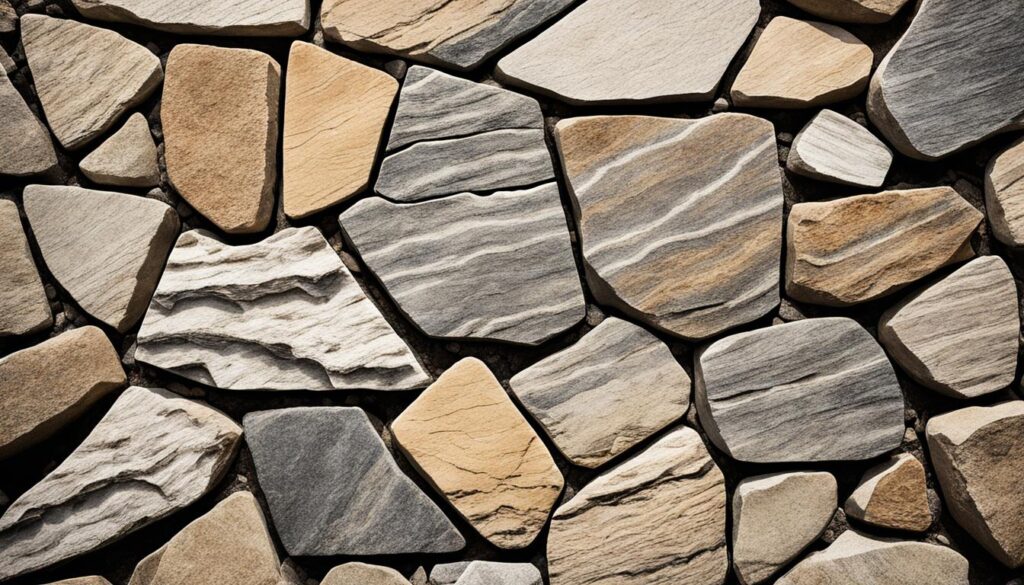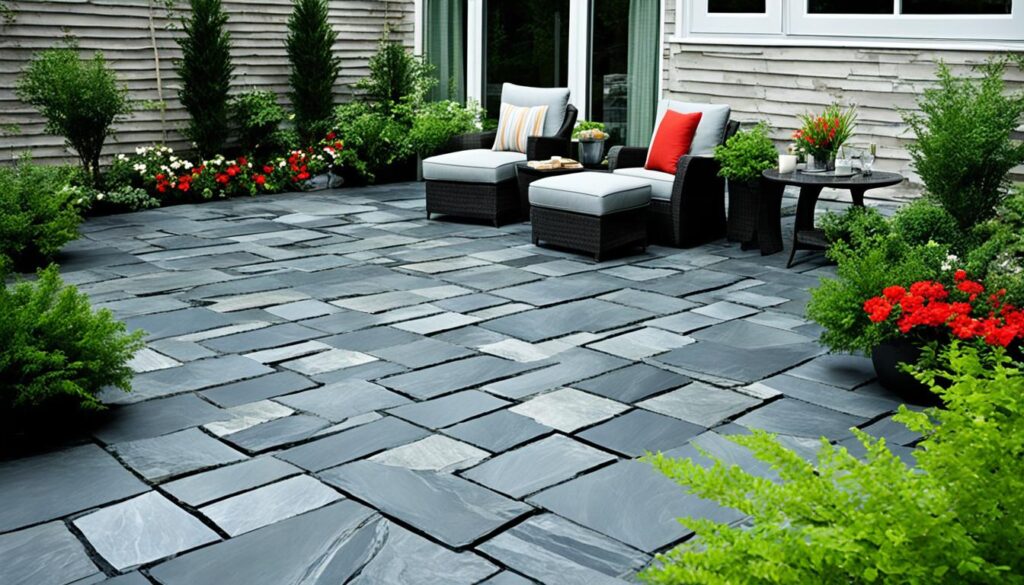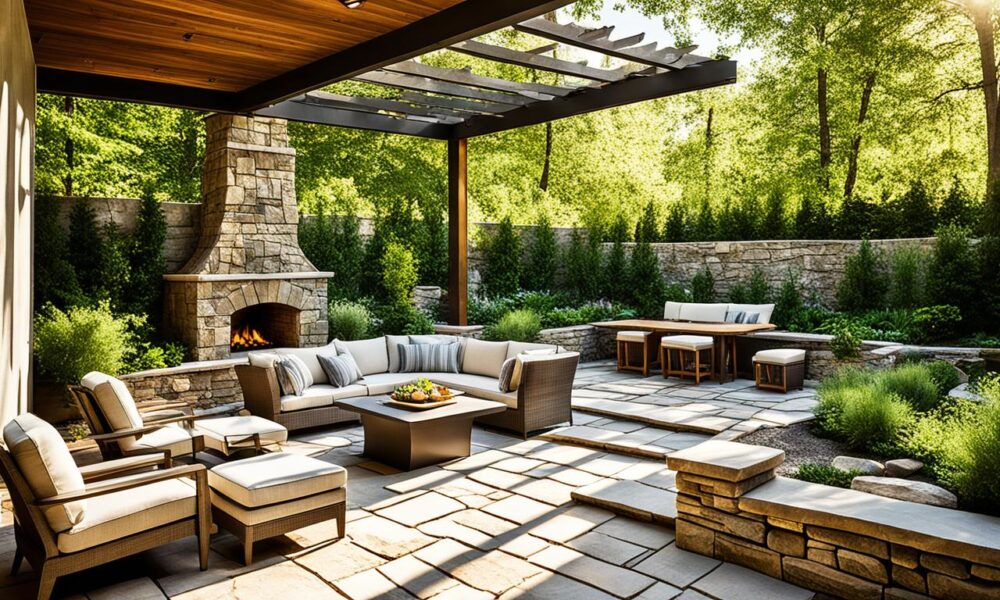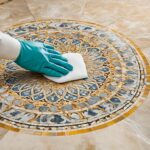Outdoor Patio Stone Types: Pros & Cons Guide
Patios are key for outdoor living, supporting furniture, cooking gear, and plants. Choosing the right stone is important for a strong, affordable, and beautiful patio area. Each type, like porcelain pavers, natural stones, concrete, wood decking, and composites, has its own benefits and things to consider.
Porcelain pavers stand out by holding up to 2,000 pounds without breaking. They look great but might cause water to collect underneath if not installed properly. Natural stones, such as granite and sandstone, are beautiful but need more care and tend to cost more.
Concrete pavers are versatile and come in many patterns, which is good for a budget. Yet, it’s best to have experts lay them to avoid water issues. Wood decks are timeless but need a lot of care to last. On the other hand, composite decking gives a similar look with less work because it’s made from recycled materials.
Gravel is basic and drains water well but can wear away. Brick is another choice that’s good for water flow and looks classic. Knowing what each option offers will let people choose wisely for their outdoor floors.
Key Takeaways
- Porcelain pavers support heavy loads of up to 2,000 pounds and can be dry-laid on various surfaces.
- Natural stones like granite and limestone offer durability and aesthetic appeal but can be costly and require maintenance.
- Concrete pavers are versatile and budget-friendly but should be professionally installed to prevent drainage issues.
- Wooden decks need regular maintenance, whereas composite decking is a low-maintenance, eco-friendly option.
- Gravel and bricks are affordable options with unique advantages like ease of installation and good drainage.
Introduction to Popular Patio Stone Choices
Selecting the right outdoor patio stone options is key to improving your outdoor space. Your patio is more than just an extra part of your home. It’s a spot for chilling out and having fun. So, what you pick matters a lot for both looks and how it’s used.
You have many choices for popular patio stone options. There’s tough porcelain, timeless natural stone, and adaptable concrete. You can also choose from bricks, wood, or a mix of materials. Knowing what each one brings helps pick what suits your taste, budget, and how you’ll use the space.
About 60% of materials for outdoor living areas are patio stones, showing how important they are in design. For paths, many people go for natural stones like granite, slate, or limestone. These choices last long and don’t need much care. They also stand up well to the weather.
Flagstone is a top pick for patios because it comes in many natural colors. It also fits in well with lots of landscapes. Its different shapes can make your patio special.
Concrete is a good value choice. It’s tough and easy to care for. Patios made of it often cost less than decks. You don’t have to seal or wash them every year. Pavers are also a favorite for how they come in many shapes, sizes, and colors.
| Material | Advantages | Disadvantages |
|---|---|---|
| Natural Stone (Flagstone, Slate, Limestone) | Timeless look, high durability, low maintenance | Can be expensive, may be slippery when wet |
| Concrete | Durable, customizable, low maintenance | Can crack over time |
| Bricks | Fire-resistant, minimal maintenance, classic beauty | Can crack in cold weather, may become slippery |
| Pavers | Affordable, durable, easy to install | May require regular cleaning, can become uneven over time |
Picking the best outdoor patio stone options can really make your patio stand out. You create a place that looks good, lasts long, and fits the way you use it.
Natural Stone for Patios: An Overview
Natural stone patios are a favorite for many. They are made from materials like flagstone, slate, or limestone. These stones last a long time and bring a natural touch to outdoor areas. We will look at the good and not-so-good points of using natural stone for patios. This will help you see if they are right for your project.
Benefits of Natural Stone Patio
One major plus of natural stone patio is how long they last. Stones like granite and marble hold up well over years. They keep looking good despite lots of use. Plus, stones like slate are good for walking on since they help prevent slipping.
These patios come in a lot of different looks. You can pick from many textures, colors, and patterns. This means you can make your patio stand out with your own special touch. These stones are strong too. So, you don’t have to worry about them breaking under lots of use.
Disadvantages of Natural Stone Patio
However, there are some downsides to using natural stone patio. They can be more expensive than other materials. And putting them in takes more work and skills.
You have to take care of these patios more too. This helps them stay looking good and not get damaged. Sometimes, certain stones don’t do well in the rain or they can easily get scratched. Fixing natural stones is also more costly and hard.
| Aspect | Natural Stone | Cast Stone |
|---|---|---|
| Cost | Higher | Lower |
| Durability | Excellent | Good |
| Maintenance | More frequent | Less frequent |
| Repair | Expensive and difficult | Cheaper and easier |
| Customization | High | Consistent color |
Flagstone: Characteristics, Pros, and Cons
Flagstone is a favorite for patios. It consists of flat, sturdy stone slabs. These stones come in different shapes and colors, like red, blue, and yellow. They are at least 1-1/2 inches thick, avoiding easy breakage.

What is Flagstone?
Flagstone is nature’s flat rock, perfect for outdoor spaces. Rocks like sandstone, limestone, and bluestone make up flagstone. Its rough texture looks nice and prevents slipping when it’s wet. With care, flagstone can last for ages, making it a smart choice for many.
Pros of Using Flagstone
Flagstone thrives in tough weather, making it ideal for places like Arizona. It’s easy to care for, often needing just a sweep or a wash. You can set it dry or with mortar, letting you match any backyard style. Joints can even have plants, giving your area a lush look.
- Natural appearance
- Long-lasting durability
- Good traction when wet
- Variety of colors and shapes
- Suitable for both dry set and mortar installations
Cons of Using Flagstone
However, flagstone does have its downsides. It costs more than usual paving stones and needs pros to put it in. Without proper installation, wet flagstones are slippery and can pose a tripping risk. Deciding to seal or not is a tough call, since the wrong sealer can damage the stone.
- Higher cost for materials and installation
- Potential for slipperiness when wet
- Risk of tripping hazards
- Debate on sealant application
- Heavy and labor-intensive installation
Think carefully if flagstone suits your patio needs and style.
| Pros | Cons |
|---|---|
| Natural appearance | Higher cost |
| Durable and long-lasting | Can be slippery when wet |
| Variety of colors | Potential tripping hazards |
| Good traction | Sealing debate |
| Minimal maintenance | Labor-intensive installation |
The Benefits and Drawbacks of Using Limestone
Limestone is praised for its toughness and many uses, especially outdoors. You can make it look sleek and shiny by polishing it. Or, for a more rugged feel, you can keep it rough. One great thing about limestone is it’s easy to get and not too expensive. It’s a more budget-friendly option for paving that doesn’t sacrifice quality.
What makes limestone stand out is its toughness. It doesn’t absorb much water, so it’s less likely to break, especially from cold weather. This quality makes it perfect for places like driveways, patios, and pools. Plus, choosing limestone helps the environment because it lasts a long time and you don’t need to replace it often.
“Low maintenance requirements, slip resistance, and weather durability are some of the standout pros of using limestone.”
But, there are things you need to watch out for when thinking about limestone. It needs to be sealed against stains, as it can be harmed by acids. And not all limestone can handle changes in temperature without cracking. Over the years, it might get scratched and lose some of its color.
You must install limestone correctly and look after it to keep it looking good. Even with these challenges, its charm, style, and property value benefits can make it appealing to many.
| Pros | Cons |
|---|---|
| Durable and weather-resistant | Requires regular sealing |
| Eco-friendly and sustainable | Sensitivity to acids |
| Cost-effective | Potential frost damage |
| Low maintenance | Prone to scratches and fading |
| Slip-resistant | Inconsistent color shading |
Types of Natural Stone for Outdoor Patios: Pros and Cons
Natural stones are the top choice for outdoor patios because they look great and last a long time. Granite and marble are especially popular. They bring their own special features and advantages.
Granite
Granite is known for being very hard and tough. This makes it great for outdoor spaces. It can withstand harsh weather like freezing and thawing well.
This stone lasts a long time with little effort. It’s perfect for places that get a lot of foot traffic. With many colors and patterns available, you can make your space unique and attractive.
But, granite tends to be more expensive. This is because it’s so durable and looks good. In wet areas, it might be slippery. You may need to add something to make it safer.
- Pros: Extremely durable, weather-resistant, low maintenance, variety of colors and patterns.
- Cons: Expensive, may need anti-slip treatment.
Marble
Marble brings a touch of elegance to any patio. It’s softer than granite but still strong. When sealed well, it can handle lots of use.
It comes in many colors, giving you design flexibility. But, it can get expensive. Also, in the rain, it might be slippery. Safety is something to think about.
| Stone Type | Pros | Cons |
|---|---|---|
| Granite | Durable, weather-resistant, low maintenance, variety of colors. | Expensive, may need anti-slip treatment. |
| Marble | Elegant, smooth texture, variety of colors. | Costly, can be slippery, requires sealing. |
Both granite and marble need to be sealed often. They also require regular care. But they’re worth it for the beauty and value they bring to outdoor areas.
The Aesthetic Appeal and Maintenance of Slate
Slate is a perfect choice for your patio. It brings a unique, moody look with shades of grey, green, and orange. The various textures make it not only beautiful but also sophisticated.

But, having slate means you need to care for it. It’s softer than granite or marble. It might flake or split if it gets too wet. This is why sealing it well is key for its upkeep.
Keeping up with sealing slate is important. It protects it from water damage and keeps it looking good. This, in turn, helps it last longer. By taking good care of slate, you ensure it remains a stunning part of your outdoor area for years.
Let’s compare natural stones used in outdoor patios:
| Stone Type | Durability | Colors | Maintenance | Cost |
|---|---|---|---|---|
| Granite | Extremely Durable | White to Black | Moderate | High |
| Marble | Durable but Porous | White to Black | High | High |
| Slate | Durable but Softer | Grey, Green, Brown, Tan, Orange | High | Moderate |
| Limestone | Softer and Porous | White to Brown | High | Moderate to High |
| Travertine | Brittle and Porous | Creamy White, Beige | High | Moderate to High |
Slate is both elegant and practical for patios. Its upkeep is crucial for maintaining its beauty and longevity. This makes it a smart choice for those looking to enhance their outdoor areas.
The Versatility of Concrete Pavers
Concrete pavers have changed a lot since they first started being made in the 1940s. People love them for how they can look like real stone. This means homeowners have many choices for their outdoor spaces.
Concrete Pavers Overview
There are two main types of concrete pavers: interlocking and architectural slabs. Interlocking pavers are strong and last a long time. They can take up to 2,500 pounds per square inch (PSI). But, natural stone pavers are even stronger, lasting with up to 8,000 PSI.
Advantages of Concrete Pavers
Concrete pavers pros and cons show they have many good points. They are a more affordable choice than natural stone pavers. Installing and maintaining them also takes less time and skill. This saves on labor costs too.
- Durability: Pavers are four times more durable than plain concrete.
- Maintenance: Easier to maintain with simple cleaning protocols.
- Sustainability: Options like permeable pavers contribute to environmental sustainability by reducing runoff and promoting groundwater recharge.
Disadvantages of Concrete Pavers
Yet, there are downsides to concrete pavers versatility. Bad installation can lead to big drainage problems. This shows the importance of getting professionals for complex jobs. Over time, concrete pavers might crack, impacting their look. This is more visible than with natural stones.
| Parameter | Concrete Pavers | Natural Stone Pavers |
|---|---|---|
| Durability (PSI) | 2,500 | 8,000 |
|
ROI in Backyard Spaces |
Moderate | 9% |
| Cost | Lower | Higher |
| Installation | Easier, less precise | Complex, requires precision |
| Eco-friendliness | Less eco-friendly | More eco-friendly |
Want to learn why some prefer natural stone over concrete? Check out this guide. It explains all about the different choices for outdoor patios. Natural stones offer their unique benefits, so the best pick depends on your specific project needs.
Brick: Classic Choice for Patios
Brick patios have been a favorite for ages. They offer style and charm to outdoor areas. From rustic to modern, brick fits every look.
Historical Context
Many ancient cultures used brick outdoors. These bricks, made from clay and fire, last long. They can be laid in patterns like herringbone and basket-weave, adding unique beauty.
Advantages of Using Brick
The benefits of a brick patio are many. They are affordable, usually costing between $10 to $20 per square foot. Bricks are also good for the environment because they can be recycled. They don’t stain or fade, keeping their color for years. Bricks add a classic look to your home that can increase its value.
- Cost-Efficiency: Installation costs range between $10 to $20 per square foot.
- Durability: With proper care, brick pavers can last around 25 years.
- Environmental Benefits: Recyclable material that breaks down naturally.
- Versatile Design: Enables intricate patterns like basket-weave or herringbone.
Disadvantages of Using Brick
But, bricks do have downsides to consider. They might crack under heavy weight or in cold. Over time, they can flake and wear. You need to reseal them every 2-3 years. Installing them is also hard work and often needs a pro.
- Cracking Risks: Prone to cracking under heavy pressure or cold conditions.
- Weathering: Bricks may flake and disintegrate over time with exposure to elements.
- Maintenance: Need for resealing every 2-3 years to maintain appearance.
- Labor-Intensive Installation: Professional installation may be necessary for the best results.
In the end, bricks are still a top pick for patios. Their mix of affordability, durability, and timeless beauty wins over their challenges.
Exploring the Benefits and Drawbacks of Porcelain Pavers
Porcelain pavers bring together beauty and functionality for outdoor areas. They are made from thick, strong materials. These pavers are great because they can handle frost, stop skidding, and resist staining. They fit smoothly with indoor floors, making your home’s look consistent.
They don’t soak up water, a feature of their making. This means they won’t get damaged easily by ice forming and melting. While concrete pavers may break in cold, these hold up well. Their thickness ranges from ¾” to a durable 1 1/8” (3cm), making them tough for heavy use.
They also offer good grip, even when wet, because of their textured surfaces. This makes them a great choice for those worried about slipping. They also stay looking good and don’t get discolored or get white patches (efflorescence).
Even with their many benefits, porcelain pavers have a few downsides. They can be costly at first, more so than concrete pavers, because of how they’re made. The price has come down in the last five years, but it’s still a big buy. Putting them in can also be tricky, needing detailed work and experience. This might end up costing you more for skilled help and getting the ground ready.
Using special tools like diamond blades and wet saws is a must for working with porcelain pavers, which could add to the expense. If you ever need to fix them, making sure they match the original ones perfectly is a challenge.
Making them look truly natural can be hard, even though they’re designed to look like different materials. Here is a detailed comparison:
| Feature | Porcelain Pavers | Concrete Pavers |
|---|---|---|
| Thickness | ¾” – 1 1/8” | Varies |
| Size Range | 4” x 4” to 96” x 48” | Varies |
| Water Absorption | Low | Higher |
| Slip Resistance | High | Moderate |
| Maintenance | Low | Moderate |
| Installation Cost | Higher | Lower |
So, when picking porcelain pavers, think about their good and not-so-good points. On one hand, they last long, are easy to keep up, and look nice. On the other, they cost more at first and need a precise installation. But their durability and low upkeep over time might just make them worth it.
Wooden Decking vs Stone Patios
Homeowners often choose between wooden decking and stone patios for their outdoor space. Each has its own benefits and things to consider, like maintenance needs. Your style and how much upkeep you’re willing to do can help make the decision easier.
Overview of Wooden Decking
A wooden deck gives your home a cozy, classic feel that many love. It’s usually built with strong wood like cedar or redwood, so it lasts. But, decks need more work to stay in good shape. You’ll have to clean it often and add protective layers. This keeps it from wearing down. With the cost of quality materials, keeping up the maintenance helps your deck last longer.
Pros and Cons of Wooden Decking
Wooden decks are beautiful and can fit many different styles, from boho to rustic. It’s important to source wood that’s eco-friendly.
Yet, there’s a lot of upkeep and they can become slippery when wet. Bugs like termites can also be a problem, so you have to be on the lookout. If maintenance isn’t your thing, consider composite decking. It’s durable like stone patios but looks like wood.
Overview of Stone Patios
Stone patios offer a sturdy and stylish alternative to wood. They are naturally strong and you can choose from many types and designs. Stone is often cheaper and easier to care for than wood, making it a smart choice for money-conscious homeowners.
Wooden Decking vs Stone Patios: A Comparison
| Aspect | Wooden Decking | Stone Patios |
|---|---|---|
| Maintenance | High (cleaning, staining, sealing) | Low |
| Initial Cost | Higher | Lower |
| Design Versatility | High (Bohemian, rustic) | Moderate (Variety of styles, textures) |
| Return on Investment | Higher over time | Lower but durable |
| Longevity | 10-20 years (wood), 25-30+ years (composite) | 25-30+ years |
| Average Cost per Sq. Ft. | $9 (wood), $6 (pressure-treated), $5-$13 (composite) | $6 (brick), $4 (concrete), $5 (simple brick paver), $12 (stamped concrete) |
| Privacy | Low | High (particularly enclosed patios) |
Conclusion
When choosing a stone for your outdoor patio, you need to consider looks, how well it works, how long it lasts, and your budget. Each type of patio stone, whether natural, concrete, or porcelain, brings certain benefits and things to think about.
Natural stones are from places like Italy, Spain, or the United States. They might cost more, but they are a smart choice. They last a long time, are friendly to the environment, and keep looking good with time. Still, using them costs more at the start and may be harder to install.
Concrete stones are known for being versatile and affordable. However, they need more care and might crack. Porcelain pavers stand out for not easily getting marked by frost, not being slippery, and not staining. But, they could have problems with water going away and might be more expensive. It’s essential to think through these points to make sure your outdoor space is both lovely and long-lasting.



